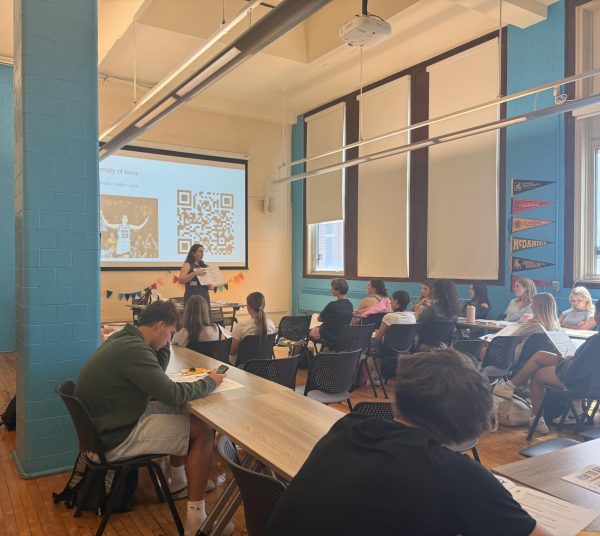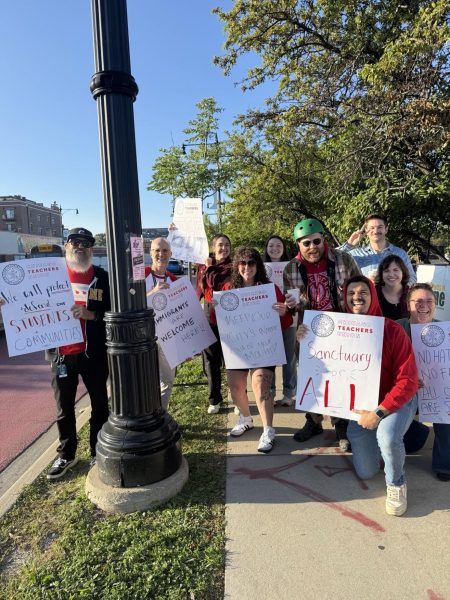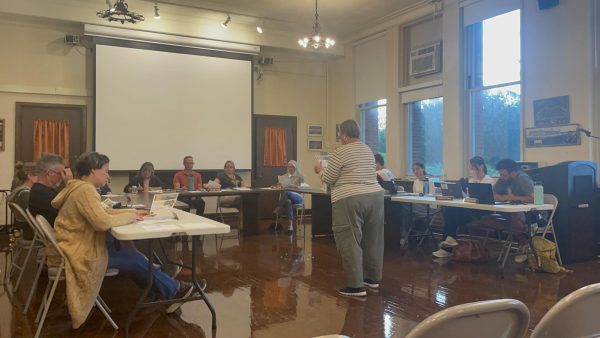Attendance policy impacts ethnic club dancers
Chinese club members Lilly Nguyen, Div. 770, and Mei Ochs, Div. 758, practice their I-Days routine.
The first day of International Days should be the “big day” for the ethnic club dancers, but for some it has become Feb. 2, the end of the first semester. On that day, the attendance office will determine which students are eligible to perform based on their attendance. Ethnic club members that fail to meet the attendance policy will be unable to perform during I-Days alongside their club.
A total of 33 ethnic clubs are a part of International Nights, with roughly 750 students participating in the event, according to Assistant Principal Mrs. Hanly. For these students, their attendance has become an important deciding factor in their ability to participate in International Days/Nights.
Lane’s attendance policy states that students are expected to maintain a minimum of 95 percent attendance to participate in school events, one being International Days. This means that students who have missed more than 4.5 days during the first semester will be ineligible.
CPS follows a School Quality Rating Policy (SQRP) to rate a school’s annual performance. According to Hanly, Lane is currently at a 1+ rating, which is the highest a school can be rated.
Lane’s attendance has been dropping slightly in the past years, according to Hanly. Attendance is one of the factors that impacts a school’s rating. However, Lane’s rating is not the only reason behind the policy.
“I don’t want students to think that these things are punishments,” Hanly said, in regards to the attendance policy. “Attendance is important regardless, and I think that that’s nothing new that we’re stressing. Kids need to be here in the building every day participating.”
Dr. Zakieh Mohammed, the CPS Senior Manager of Attendance and Truancy, agreed that attendance is a crucial part of a student’s participation in a learning environment.
“The Consortium for Chicago School Research has found that as early as preschool, attendance does impact the larger trajectory of a person’s educational path,” Mohammed said.
According to Mohammed, CPS implements attendance using a Multi-Tiered System of Support (MTSS). This method not only provides clear guidelines on attendance, but also makes support available to students struggling with attendance and academics.
“In the case of this rule, my understanding is that the 95 percent expectation does not exclude a student from participating or joining any extracurricular activities, like a club or sport,” Mohammed said. “But it does ask that a student have a specific attendance average to be part of larger events that take a great deal of commitment.”
Despite this, Monica Zalewska, Div. 774, views the exclusion as an unfair aspect of the policy. Zalewska tore her ACL, and will be required to undergo surgery, resulting in her missing five days of the upcoming semester. This puts Zalewska at risk of not meeting the 95 percent required attendance by the end of year.
“I worked so hard all four years, and I’m not even able to walk down the aisle,” Zalewska said, in regards to the impact of the attendance policy on graduation.
Chinese club president, Stephanie Tanaka, Div. 754, understands the need for a policy to enforce attendance, but question the fairness behind it.
“Your health comes before your education,” Tanaka said. “And I think that they don’t get that some days people do get overstressed, or they do get really sick. It’s an overkill on what is exempt and what isn’t.
Like many other presidents, Tanaka will be responsible for notifying club members that do not meet the required 95 percent attendance. These members aren’t excluded from participating in the club, but will be unable to dance during I-Days.
Some presidents, like Maddie Monticello, Div. 759, have been able to maintain the required attendance in their clubs. To encourage members to keep their attendance at the required rate, Monticello said she constantly reminds her club members that they won’t be able to dance if their attendance is below the requirement.
Other presidents, such as Subin Kim, Div. 767, president of Polynesian club, have taken more direct approaches. Kim keeps up to date with her club members’ demerits and attendance rate.
Some presidents are questioning the effectiveness of the attendance policy. Tanaka questions the need for both the attendance and demerit policy.
“I feel like they should go by demerits, instead of attendance, so if you miss a certain amount of days, then you get a certain amount of demerits instead of going by 95 percent attendance,” Tanaka said.
Hanly said that the attendance policy’s impact will become more evident in subsequent years. Since the policy was implemented this year, the effects may not be immediately clear. She compared it to the impact that Lane’s demerit system has had.
“It takes a while for these new policies to work themselves out. When we first started it [ the demerit system] , did we see the impact right away?” Hanly said. “No, but we saw it year two, year three, that it decreased tardies to school. And that’s a big thing for us. I think that this [the attendance policy] will have an impact.”
Your donations directly fund the Lane Tech student journalism program—covering essential costs like website hosting and technology not supported by our school or district. Your generosity empowers our student reporters to investigate, write, and publish impactful stories that matter to our school community.
This website is more than a publishing platform—it's an archive, a research tool, and a source of truth. Every dollar helps us preserve and grow this resource so future students can learn from and build on the work being done today.
Thank you for supporting the next generation of journalists at Lane Tech College Prep!

Brianna is Vietnamese, and was born and raised in Chicago. Her favorite past time activity is napping and eating. When she’s not doing either, she likes...









